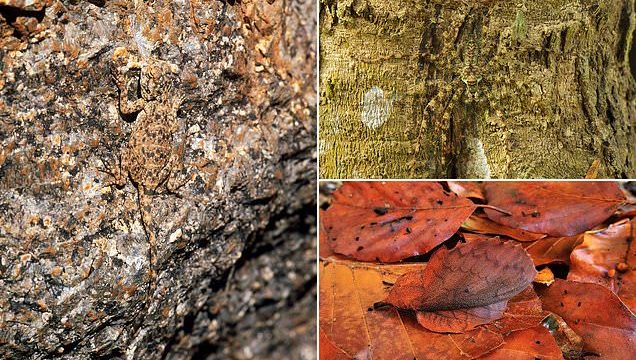The (hidden) wonders of nature: Incredible photos show how animals from lizards to spiders and moths perfectly camouflage themselves
- Camouflage is important mechanism for both predators and prey, allowing them to eat or avoid being eaten
- Some evolved the mechanism, others can quickly change their skin colour, while some construct disguises
- This gallery shows how a range of different species from across the world blend in with their environments
These incredible images show how animals across the world use camouflage to either eat or avoid being eaten.
Some – like the southern agama lizard from Namibia or the lichen spider from Australia – can change their skin colour to blend in with their surroundings.
Others – such as the pygmy seahorse of Indonesia or lappet moth from Switzerland – have evolved to look like their surroundings over thousands of years.
Then there are the likes of the righteye flounder or Peringuey’s Adder which use a mix of natural skin colour and disguise – burying themselves in sand – to hide themselves from prey until it is too late.
Here, Mail Online has compiled a gallery of some of nature’s masters of disguise. So how many can you spot?
A southern Rock Agama Lizard blends in with a rock in Namibia, left. These lizards are able to change colour, allowing them to blend in with their surroundings or – during mating season – to display bright colours to attract a female. Right, a pigmy seahorse disguises itself against coral in Indonesia. Colour varies between the same species, depending on what type of coral they live on. Some will spend their entire lives on a single piece of coral
A lichen spider disguised against tree bark. While it is not known exactly where this image was taken, the species is found in Australia, Papua New Guinea, and Indonesia. They can change colour but only when they shed their skins, after which the new pattern becomes fixed until their next moult. These spiders hunt by ambush, making camouflage an important weapon
A species of lappet moth blends in with dead leaves in Switzerland. These moths typically do not have mouths and cannot feed, since they only live as adults for a few days. Instead, their camouflage – which they have evolved – is used to hide them from predators while they seek out a mate to breed with
A bat-faced toad blends in with dead leaves in a national park in Colombia. Like lappet months and seahorses, this camouflage has been slowly evolved, rather than chameleons who can change colour quickly. Since frogs are predators – eating small insects – the ability to hide is both a hunting mechanism and to protect them against being eaten
A longfingered scorpionfish hides among rocks, left. These fish are native to the Indian and South Pacific Oceans. Since they hunt primarily at night, the camouflage is largely a defence mechanism to protect against larger predators while they rest during the day. Right, a crocodile disguises itself at Phuket Zoo. Most crocodiles are apex predators, meaning they have no natural predators, so their disguise is to assist with ambush-hunting. They either submerge themselves completely or lay low in the water and wait for an unsuspected animal to come close enough to grab
A righteye flounder disguises itself on the seabed, exact location unknown. Flounders are ambush predators that use their natural colouring to blend in with their surroundings, though also bury themselves to increase their chances of luring prey towards them. Both eyes are situated on the right side of their bodies – distinct from lefteye flounders, which have them on the left – and they lay with them facing up, to help them hunt
A Peringuey’s adder disguises itself in the sand of a desert somewhere in Namibia or southern Angola. Another ambush predator, it buries itself underneath sand with only its eyes and tail – which are covered with natural camouflage – visible above the surface. Prey that passes by is then given a dose of venom from its fangs, and devoured after it dies
A scorpionfish hides among rocks in the Pacific Ocean. While some species are mottled in colour, others are bright orange or red, allowing them to blend in with corals. Their camouflage, along with venomous spines along their backs and fins, helps to protect them against predators. They hunt at night, when camouflage is not required
A stargazer fish stares up from the seabed near Blairgowrie Pier in Melbourne, Australia. Stargazers are a dark-brown colour, which helps them to blend in, but they largely rely on constructing a disguise for themselves by digging into the sandy seabed with their eyes – positioned on the tops of their heads – staring upwards at passing prey
Source: Read Full Article











